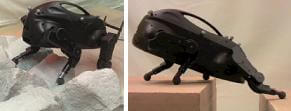
Researchers at the Computational Learning & Motor Control Lab at the University of Southern California have taught an old robot dog new tricks. USC students developed a new walking method based on evaluating terrain types and tested out their ideas with Boston Dynamics‘ Little Dog robot. The new walking technique allowed the bot to conquer a wide variety of terrain and, impressively, compensate for obstacles it could neither see nor predict. The work was presented at ICRA 2010 and won the Overall Best Paper Finalist award, marking it as one of the top four papers out of more than 2000 submitted. Check out Little Dog strutting its stuff in the great video from USC below.
MIT’s CSAIL actually used the Little Dog robot for very similar work last year. The two teams used different approaches to getting the robot to walk across difficult terrain, but the speeds each achieved are fairly similar. The big improvement USC seems to have made is giving the robot the means to adjust to variations in terrain that it cannot see. This “floating base inverse dynamics control” will allow Little Dog (and other bots) to adjust the force applied to their limbs in a responsive way to unseen obstacles (1:40). As they mention in the video, this may let robots interact safely with humans:
While it may seem strangely competitive for MIT and USC to be tackling the same project, this is actually a sign of how shared platforms will accelerate innovation. Boston Dynamics’ Little Dog serves as a standardized robot that groups can adopt to test their (quadripedal) walking ideas without having to build their own robot. Willow Garage is using a similar concept to accelerate open source robotics with their PR2 Beta Program. With many teams like MIT and USC both looking at how to improve robot movement, the chances that any one group will achieve a breakout success increases. Work like this may one day help walking robots match and even outperform humans in dangerous locations all over the world. Sounds good to me. C’mon Little Dog, fetch my newspaper…it’s at the top of the AggroCrag.
[image credit: Kalakrishnan et al, ICRA 2010]
[source: CLMC at USC, Kalakrishnan et al ICRA 2010]


